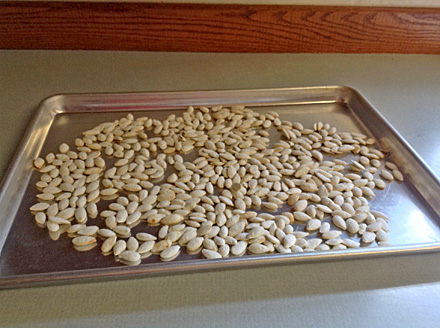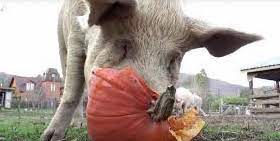What To Do with the Pumpkins Now
by Kathleen Curthoys, Fairfax Master Gardener
 They’ve been celebrities for a few autumn weeks of fame. The ones we lit up for the October festivities — the jack-o’-lanterns — are still grinning at us. What happens now that it’s November? How can we bear to be rid of these beguiling smiling gourds after all the October fun?
They’ve been celebrities for a few autumn weeks of fame. The ones we lit up for the October festivities — the jack-o’-lanterns — are still grinning at us. What happens now that it’s November? How can we bear to be rid of these beguiling smiling gourds after all the October fun?
We have to do something, and after all, who wants to be that guy stringing Christmas lights while last month’s pumpkins rot in the garden? Or wondering why a vine with suspiciously huge leaves popped up from the lawn in the spring? It happens. So what do we do with all these pumpkins?
When asked by a TV reporter why so many people gathered at an annual Delaware event to dispose of pumpkins in ingenious ways, to include huge catapults hurling them across fields, a participant replied, “Sometimes you just have too much of a certain vegetable.”
For most of us, it shouldn’t take medieval battle machinery and degrees in engineering to solve this. Throwing the pumpkins in the garbage is easy, but piles of them in landfills will decompose and emit the greenhouse gas methane.
Composting is a good solution to get the benefit from the nutritious pumpkins, or other organic matter, in your garden for future years. If you have used decorating materials on the pumpkin, be sure they are nontoxic before composting. Remove the seeds if you haven’t already. Chop up the pumpkins with a shovel to help speed decomposition, and then work the pieces into the compost pile.
You can use the seeds from fresh, healthy pumpkins in your garden next year, though be mindful that because the pumpkin may have been cross-pollinated, the pumpkins (members of the Cucurbitaceae family) you grow from the seeds next year may not look like the pumpkin you have now. Shapes, colors and sizes may be different.
 Remove them from the pumpkin and wash with warm soapy water until pulp is removed. If carving the pumpkin for decoration, promptly save, clean and store the seeds, keeping them away from other materials used for decoration. Drain seeds in a strainer, then spread them out on a screen to dry, turning them over after a couple of days. Let them air dry in a cool, dry place for at least three weeks. When they are dry, package them in paper (not plastic) and store them in a cool, dark, dry place.
Remove them from the pumpkin and wash with warm soapy water until pulp is removed. If carving the pumpkin for decoration, promptly save, clean and store the seeds, keeping them away from other materials used for decoration. Drain seeds in a strainer, then spread them out on a screen to dry, turning them over after a couple of days. Let them air dry in a cool, dry place for at least three weeks. When they are dry, package them in paper (not plastic) and store them in a cool, dark, dry place.
To grow pumpkins from seed in the spring: You can sow seeds indoors in small 3-inch containers three weeks before planting time around mid-May. When seedlings emerge, pinch out the weaker ones. You can also plant seeds outside in the spring after danger of frost has passed and the soil has warmed up to more than 55 degrees F (12º C) consistently. Mix compost into the soil before planting seeds outdoors in a spot that gets at least 6 hours of sun a day and preferably 8 to 10 hours of sunlight. Plant seeds about ½-inch deep (10 mm) in the soil.
Carefully consider what pumpkin you use for eating. Carved pumpkins should not be consumed, as bacteria will grow on cut pumpkin, which could present a health danger even within a few hours after carving. In addition, if outdoors, jack-o’-lanterns will be exposed to potential contaminants and outdoor creatures. These larger pumpkins may be stringy and not great for eating, anyway. Good choices for eating are fresh, healthy “pie pumpkin” or “sweet pumpkin” types, which are smaller and sweeter than jack-o’-lantern pumpkins. Pumpkins can be cooked or baked and eaten if no toxic materials have been used on or inside them.
 They are a good low-calorie, low-fat source of fiber, beta-carotene, Vitamin A, Vitamin B, potassium, protein and iron. They can be used for stews, soups, purees, pies and other dishes. Pumpkin seeds can be toasted or roasted for snacks, as well, or added to many types of recipes. If pumpkins have not been carved and skin is intact, they may be stored indoors and stay edible for weeks or months. It is recommended to store pumpkins in a dry area that stays between 50 and 55 degrees F (10 -12º C).
They are a good low-calorie, low-fat source of fiber, beta-carotene, Vitamin A, Vitamin B, potassium, protein and iron. They can be used for stews, soups, purees, pies and other dishes. Pumpkin seeds can be toasted or roasted for snacks, as well, or added to many types of recipes. If pumpkins have not been carved and skin is intact, they may be stored indoors and stay edible for weeks or months. It is recommended to store pumpkins in a dry area that stays between 50 and 55 degrees F (10 -12º C).
As with other uses of pumpkins, be sure there are no toxic materials such as paint present before setting pumpkin out for wildlife such as deer or feeding it to livestock or pets. You can chop up pumpkins and set the pieces out in the woods for native wildlife to feast on during the cold months. The pumpkins can also be chopped up or pureed to add to pet food.
You can turn your pumpkin into a feeding station for birds. The National Wildlife Federation has kid-friendly instructions for making “Snack-o’-lanterns”: Using a hollowed-out pumpkin, poke small holes in the front, back and sides. Push dowels through the holes in the pumpkin, then tie pieces of rope, twine or string to the ends of the dowels. Tie the loose ends together above the pumpkin so you can hang it. Fill the pumpkin with birdseed or pumpkin seeds, then hang it outside where the birds can get to it. This would be something fun to do with your kids to teach them more about recycling and reusing organic materials.
 Local farms, zoos and shelters may take fresh pumpkins to feed their animals. For example, Pumpkins for Pigs, a Virginia-based 501(c)(3) organization, exists to put your nutritious pumpkins in the hands of farmers to feed their pigs and other animals. The Pumpkins for Pigs website lists more than 500 farms in 40 states that would like to treat their animals to donated pumpkins. An interactive map lists farmers, their contact information, drop-off instructions and what they accept — including other gourds, fruits, vegetables, Christmas trees, hay, etc.
Local farms, zoos and shelters may take fresh pumpkins to feed their animals. For example, Pumpkins for Pigs, a Virginia-based 501(c)(3) organization, exists to put your nutritious pumpkins in the hands of farmers to feed their pigs and other animals. The Pumpkins for Pigs website lists more than 500 farms in 40 states that would like to treat their animals to donated pumpkins. An interactive map lists farmers, their contact information, drop-off instructions and what they accept — including other gourds, fruits, vegetables, Christmas trees, hay, etc.
If you have space on your property and feel adventurous, you may want to consider letting the pumpkin decompose in place and see what “volunteers” sprout up next year, allowing a pumpkin patch to get established. This may be especially fun for kids, who can watch the pumpkin plants grow and mature for the next season’s gourds.
Resources
• Horticulture expert shares best ways to preserve pumpkins throughout the season, Sarah Hern,
Virginia Tech News
• Growing Pumpkins in a Home Garden, University of Maryland Extension
• Saving Gourd and Pumpkin Seeds, Karen Blaedow, Henderson County Center, North Carolina
Cooperative Extension
• Make a Snack-o’-lantern, National Wildlife Federation Green Hour
• Pumpkins for Pigs
• Dealing with pumpkins after Halloween: Debunking social media advice, Christopher Enroth, Illinois
Extension